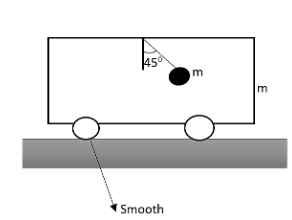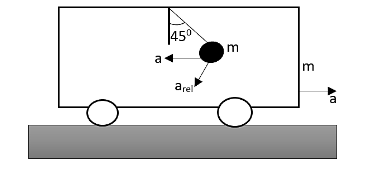
A cart of mass $m$ is placed on a smooth horizontal surface. A pendulum of mass $m$ is released from rest as shown in the figure. Then we can say that,

A. The velocity of cart just after release will be V to 0
B. The acceleration of the cart just after release will be $\dfrac{g}{3}$.
C. The velocity of the pendulum relative to the cart just after the release will be Vrel to 0
D. acceleration of the pendulum relative to the cart just after release will be $\dfrac{g}{3}$.

Answer
568.8k+ views
Hint: First of all find the velocity of the body at the time of release. Then calculate the accelerations of the pendulum in two cases. And then compare them with the options given. These all may help us to solve this question.
Complete answer:
The whole system is released from rest, the velocity of the cart and pendulum will be zero just after the release from rest. Hence the options A and C tend to be correct. Let us draw the free body diagram of the pendulum.

Let us assume that the acceleration of the cart is $a$ and \[{{a}_{rel}}\] be the relative acceleration of the pendulum. Therefore we can write that,
$mg\sin 45{}^\circ +ma\cos 45{}^\circ =m{{a}_{rel}}$……… (1)
Where $m$ be the mass of the pendulum as well as the cart, $g$ be the acceleration due to gravity, $45{}^\circ $ be the angle between the pendulum and the normal.
The tension on the string of the pendulum will be,
$T\cos 45{}^\circ =ma$…………. (2)
And also we can write that,
\[mg\cos 45{}^\circ =T+ma\sin 45{}^\circ \]
The value of mass multiplied with the acceleration will be given as,
\[ma=m\left( {{a}_{rel}}\cos 45{}^\circ +a \right)\]…….. (3)
Where \[{{a}_{rel}}\] be the relative acceleration.
From the above equations (1), (2) and (3), we can write that the acceleration will be,
$a=\dfrac{g}{3}$
And the relative acceleration will be,
${{a}_{rel}}=\dfrac{2\sqrt{2}g}{3}$
So, the correct answer is “Option A,B and C”.
Note:
Acceleration is defined as the rate of variation of the velocity. The relative acceleration refers to the acceleration felt by an observer in a frame of another object in another frame. It is the comparison of the accelerations of two bodies.
Complete answer:
The whole system is released from rest, the velocity of the cart and pendulum will be zero just after the release from rest. Hence the options A and C tend to be correct. Let us draw the free body diagram of the pendulum.

Let us assume that the acceleration of the cart is $a$ and \[{{a}_{rel}}\] be the relative acceleration of the pendulum. Therefore we can write that,
$mg\sin 45{}^\circ +ma\cos 45{}^\circ =m{{a}_{rel}}$……… (1)
Where $m$ be the mass of the pendulum as well as the cart, $g$ be the acceleration due to gravity, $45{}^\circ $ be the angle between the pendulum and the normal.
The tension on the string of the pendulum will be,
$T\cos 45{}^\circ =ma$…………. (2)
And also we can write that,
\[mg\cos 45{}^\circ =T+ma\sin 45{}^\circ \]
The value of mass multiplied with the acceleration will be given as,
\[ma=m\left( {{a}_{rel}}\cos 45{}^\circ +a \right)\]…….. (3)
Where \[{{a}_{rel}}\] be the relative acceleration.
From the above equations (1), (2) and (3), we can write that the acceleration will be,
$a=\dfrac{g}{3}$
And the relative acceleration will be,
${{a}_{rel}}=\dfrac{2\sqrt{2}g}{3}$
So, the correct answer is “Option A,B and C”.
Note:
Acceleration is defined as the rate of variation of the velocity. The relative acceleration refers to the acceleration felt by an observer in a frame of another object in another frame. It is the comparison of the accelerations of two bodies.
Recently Updated Pages
Master Class 11 Social Science: Engaging Questions & Answers for Success

Master Class 11 Physics: Engaging Questions & Answers for Success

Master Class 11 Maths: Engaging Questions & Answers for Success

Master Class 11 Economics: Engaging Questions & Answers for Success

Master Class 11 Computer Science: Engaging Questions & Answers for Success

Master Class 11 Chemistry: Engaging Questions & Answers for Success

Trending doubts
What is meant by exothermic and endothermic reactions class 11 chemistry CBSE

10 examples of friction in our daily life

One Metric ton is equal to kg A 10000 B 1000 C 100 class 11 physics CBSE

1 Quintal is equal to a 110 kg b 10 kg c 100kg d 1000 class 11 physics CBSE

Difference Between Prokaryotic Cells and Eukaryotic Cells

The camels hump is made of which tissues a Skeletal class 11 biology CBSE




